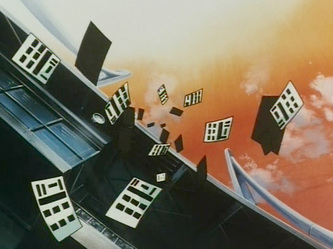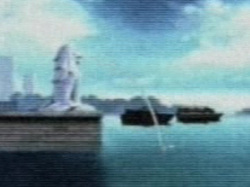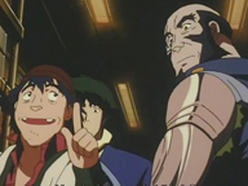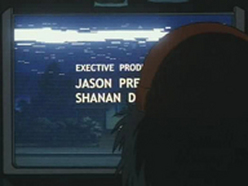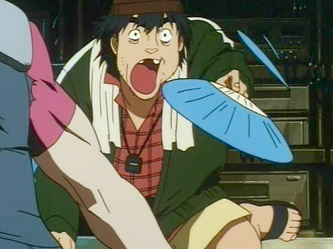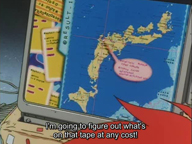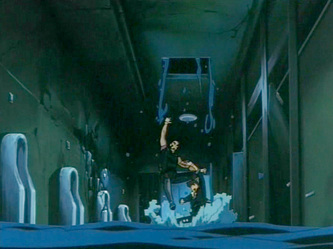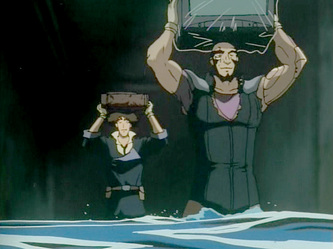Speak Like a Child: a Visual Discourse
WARNING: This article contains ENDING SPOILERS
One of the most endearing qualities I find in Cowboy Bebop is its ability to tell a balanced tale between the sad and the funny. While the underlying syndicate plot is definitively sinister and tragic, the show tells an equally good story in the comedic episodes, such as Toys in the Attic, Cowboy Funk, and Mushroom Samba.
Speak Like a Child is a classic session in that it embodies both the inimitable humour and tragedy that make Cowboy Bebop such a memorable series. More importantly, it bears the Cowboy Bebop hallmark: a flair for evoking the dramatic without losing the realism. As a departure from the usual essays, I want to spend some time to use this session as a study of the intricacies in the visual elements of the series. If you need to take a closer look at the images throughout this essay as we go through the details of the scenes, simply click on the image for full resolution.
The session opens with a horseracing scene laced with a fishing scene; Faye is gambling at the racetrack again and Spike is trying his hand at fishing. You can argue that there is nothing particularly notable about this opening sequence-- except, of course, that visually it is beautifully executed and thematically it stays true to a running gag in the series.
Speak Like a Child is a classic session in that it embodies both the inimitable humour and tragedy that make Cowboy Bebop such a memorable series. More importantly, it bears the Cowboy Bebop hallmark: a flair for evoking the dramatic without losing the realism. As a departure from the usual essays, I want to spend some time to use this session as a study of the intricacies in the visual elements of the series. If you need to take a closer look at the images throughout this essay as we go through the details of the scenes, simply click on the image for full resolution.
The session opens with a horseracing scene laced with a fishing scene; Faye is gambling at the racetrack again and Spike is trying his hand at fishing. You can argue that there is nothing particularly notable about this opening sequence-- except, of course, that visually it is beautifully executed and thematically it stays true to a running gag in the series.
The gag here being that the Bebop crew, no matter how hard they try, never seem to realise any real gains from their bounty hunts. The large bounties will somehow slip through their grasp, leaving our (literally) poor heroes with nothing but an emaciated bank account or, at best, some random small fry as consolation. And even when the crew does appear to be onto something good, they lose it immediately either by force or by will. Consider the session Honky Tonk Women, where we meet Faye for the first time. As soon as Spike and Jet get their hands on the prized data chip, they find that it is effectively no longer useful for redeeming a bounty and, ultimately, decide to gamble the chip away. In Bohemian Rhapsody, they manage to locate Chessmaster Hex but then Jet so generously/humanely/foolishly decides to pass up the chance to redeem the bounty. The habit of pouncing onto something only to end up with nothing extends to their personal life too. In My Funny Valentine, Faye thinks she has found her love in one Whitney Hagus Matsumoto, only to discover that he is a con artist. More central to the main storyline, Spike finds Julia then promptly loses her in a shootout with the syndicate. Will the cosmic forces ever give the Bebop crew a break? Well, if that turn of luck is coming, it’s certainly not happening in Speak Like a Child. Even before we see the session title, Faye and Spike lose their bet and fish respectively.
Visually, what is striking in this opening sequence is the subtlety with which this gag is conveyed—we never see Spike in the same frame as the escaping fish, and we never see Faye in the same frame with the horses either. Instead, what we’re treated to is an implicit telling of their losses—we hear the sound of something splashing into the sea and see a fistful of horseracing tickets being thrust into the air. The downward motion of the falling fish and the upward motion of the thrown tickets provide a beautiful contrast against each other, giving this ostensibly tame opening sequence an extra visual kick.
Visually, what is striking in this opening sequence is the subtlety with which this gag is conveyed—we never see Spike in the same frame as the escaping fish, and we never see Faye in the same frame with the horses either. Instead, what we’re treated to is an implicit telling of their losses—we hear the sound of something splashing into the sea and see a fistful of horseracing tickets being thrust into the air. The downward motion of the falling fish and the upward motion of the thrown tickets provide a beautiful contrast against each other, giving this ostensibly tame opening sequence an extra visual kick.
This sequence also packs a punch because, again before we see the session title, we are greeted with two recurring elements of the series: gambling and fishing. Both motifs probably deserve a more detailed treatment in a separate essay someday. Coming back to this opening sequence, note also the uncanny use of opera music for a horseracing and fishing scene—the juxtaposition is unorthodox yet it works because of the slow motion treatment to both scenes.
At last, we get to the first proper scene of the session, where we see the Bebop crew having a bit of down time in between bounty hunts. This little slice-of-life scene sheds some insight into the nature of each character. Jet is hanging the laundry while telling Spike and Ed the legend of Urashima Taro. This is not unlike a mother telling stories to her children while carrying on with domestic duties; it underscores Jet as the maternal figure onboard the Bebop. Consider also the other instances in which we catch him playing mother on the ship-- the very first time we meet Jet he’s wearing an apron cooking (beefless!) Beef and Bell Peppers for dinner; throughout the series we’ve also seen him sewing torn clothes, tending to plants, or repairing ships that the others have wrecked. So if there is a maternal figure onboard the Bebop, the honor would ironically but surely go to the man in a pink shirt. On a side note, I always found a wry sense of irony in the fact that the buffest person on the Bebop is the one who so prominently plays the mother role. Of course, this is Cowboy Bebop, a show that practically douses its stories with irony, so in retrospect this aspect of Jet is perfectly in line with the series’ mentality.
On the topic of irony, there is just a touch of this in how the CB creators chose to present the world of the future. Despite having attained a level of technological sophistication sufficient for the kind of space travel we can only now dream of, the CB world is effectively the same as the world of yesteryear. In fact, if Ballad of Fallen Angels and Asteroid Blues are anything to go by, French Gothic architecture will co-exist with interplanetary tollgates and the town of Tijuana will outlive the moon.
On the topic of irony, there is just a touch of this in how the CB creators chose to present the world of the future. Despite having attained a level of technological sophistication sufficient for the kind of space travel we can only now dream of, the CB world is effectively the same as the world of yesteryear. In fact, if Ballad of Fallen Angels and Asteroid Blues are anything to go by, French Gothic architecture will co-exist with interplanetary tollgates and the town of Tijuana will outlive the moon.
In Speak Like a Child, Hong Kong clearly serves as the canvas for the first part of the session. The similarities are striking: a packed concrete jungle, emblazoned with billboards, spilling right into a harbour. The dead giveaway is found in the screenshot above, where the three Chinese characters on the ship to the left spell out the name of an actual jetty in Hong Kong. True to Cowboy Bebop form, the attention to detail is immaculate.
It is also at this point where the Easter eggs in this session are coming thick and fast. Let’s first take a quick detour into history class: Hong Kong as a territory was leased to the British Empire when China lost in the First Opium War in 1841. The drug has not been in use in Hong Kong for well over a century. Now cut to the following scene in this session: Spike and Jet are hunting for an electronics store. The street scene is that of a typical modern Hong Kong alley (image: below left). It’s the type of setting you’d find in the 21st century, packed with neon lights and – what’s this – a man on the left with an opium pipe?! Also, in the same scene, the yellow neon sign reads "飛利浦", which is the name of Phillips, the electronics brand, in Chinese (image: below right). Clearly, the CB production team did their research.
It is also at this point where the Easter eggs in this session are coming thick and fast. Let’s first take a quick detour into history class: Hong Kong as a territory was leased to the British Empire when China lost in the First Opium War in 1841. The drug has not been in use in Hong Kong for well over a century. Now cut to the following scene in this session: Spike and Jet are hunting for an electronics store. The street scene is that of a typical modern Hong Kong alley (image: below left). It’s the type of setting you’d find in the 21st century, packed with neon lights and – what’s this – a man on the left with an opium pipe?! Also, in the same scene, the yellow neon sign reads "飛利浦", which is the name of Phillips, the electronics brand, in Chinese (image: below right). Clearly, the CB production team did their research.
Later on we see the Merlion in Faye’s videotape, which points us to Singapore. There’s no irony or Easter egg in this, in case you were wondering about the point of these “backdrop” observations. Quite simply, I consider both Hong Kong and Singapore home and it must be said that there is something distinctly awesome about seeing your own cities validated by a cameo in a timeless series like Cowboy Bebop. This must be how Pinocchio felt when he became a boy.
Coming back to the scene, we’re treated to yet another Easter egg moments later when Spike and Jet are at the antique electronics shop. Mr. Obsessed-With-20th-Century-TV-Shows is just finishing an episode of an old drama. When you have a drama referencing “my twin sister” and Minnesota, it’s not hard to put two and two together to come up with Beverly Hills 90210. If that’s not blatant enough, the disambiguated names “Shanan D’ha-“ and “Jason Prest-“ appear in the ending credits, a reference to Shannon Doherty
and Jason Priestley
who played Brenda and
Brandon
Walsh respectively in the original Beverly Hills 90210.
And as this hilarious scene confirms, the CB creators will hold nothing sacred when they decide to have a good time with irony -- not even the stereotypical fan of anime, the very medium Cowboy Bebop relies on to tell its story.
Another Easter egg can be found when Spike & co. are back in the Bebop’s living room. Ed is running a search and pulls up a map on her computer to show where they can get a beta tape player. It so happens that the map displayed is that of Japan—only turned upside down. And the exact location of the allusive beta tape is – of course – Tokyo. As an aside, it amuses me to no end that Ed calls her computer “トマト”, or tomato in English. The tomato, as you may know, is not a vegetable but a fruit. And as we all know, in real life there sits in Silicon Valley a certain computer giant that also, curiously, goes by the name of a fruit… tongue-in-cheek, much?
Another aspect in this session that bears mentioning is the way that separate scenes echo each other to form a seamless narrative. We snap to the betting grounds to see how Faye is faring. As it turns out, she just lost a massive bet. There goes all her money. And the first thing to appear as we segue to Spike and Jet? A maneki neko, or money cat, an auspicious charm piece that is commonly placed at shopfronts in Japan to encourage good fortune. This series really likes its irony in heavy doses.
At this point, the story unfolds in earnest. Spike and Jet descend some 467 feet below sea level to obtain their own tamatebako, but not without some terrific mishaps. Yes, there is a whole lot of water just like in the Urashima Tao legend. Alas, there is no princess and it well and truly stinks when you crash land straight into the toilet, barely missing the urinals.
But of course our heroes manage to get their hands on the intended goods and leave looking pleased as punch. All this to set the stage for the hilarious let down in the following scene, in which we discover 1) they hauled the wrong kind of tape player and 2) they needn’t have gone to all that trouble in the first place because 3) the right type of beta tape player was being delivered to them.
At this point, all seems lost. Faye has lost her fleeting fortune while Spike and Jet are none the wiser about the mystery tape. Everyone is back to square one. It is at this point that Faye chooses to call the one place she could remotely consider “home”. This has huge ramifications in the development of the characters’ relationships but we’ll stick to the visual aspects at hand. Faye places a call to the Bebop but it is Ein that answers. The situation has both figuratively and literally “gone to the dogs”.
At this point, all seems lost. Faye has lost her fleeting fortune while Spike and Jet are none the wiser about the mystery tape. Everyone is back to square one. It is at this point that Faye chooses to call the one place she could remotely consider “home”. This has huge ramifications in the development of the characters’ relationships but we’ll stick to the visual aspects at hand. Faye places a call to the Bebop but it is Ein that answers. The situation has both figuratively and literally “gone to the dogs”.
Then, like a good deux ex machina, another delivery company chooses this moment to show up with the much needed beta tape player. Aptly, the beta tape delivery company that arrives earlier, at the beginning of the session, resembles a tortoise while the company delivering the tape player resembles a hare. The CB creators knew their Eastern and Western fables alright. It’s also interesting to note the sheer variety of animals that appear in rapid succession throughout Speak Like a Child. We had (in no particular order) a cat, a tortoise, a hare, some horses, a fish, and let’s not forget the hordes of dogs - all in the span of a 20-minute session with a proper storyline. They sure know how to pack it in.
Ironically the tape player, which is supposedly the last piece of the puzzle, brings more questions than answers. We’ve only seen the tip of the iceberg that is Faye’s mysterious past. How long has it been since the taping? Who sent the tape and tape player to her? Is this sweet and earnest child the real Faye? But if the current Faye has no memory of that past version of herself, is the original Faye effectively dead? Is the scheming and sly Faye that we know the real Faye now? Suddenly it gets all very Ship of Theseus-esque, if you actually want to overthink this.
All told, Speak Like a Child is like any other Cowboy Bebop session in its kaleidoscopic qualities. No matter how you choose to look at it, its cornucopia of motifs, themes, Easter eggs and symbols will keep you wondering what other little details have been planted but gone unnoticed, waiting to be discovered at the next re-watching.
[by Leigh].
All told, Speak Like a Child is like any other Cowboy Bebop session in its kaleidoscopic qualities. No matter how you choose to look at it, its cornucopia of motifs, themes, Easter eggs and symbols will keep you wondering what other little details have been planted but gone unnoticed, waiting to be discovered at the next re-watching.
[by Leigh].
Want to share your thoughts on this essay? Join in the discussion in the Comments section:
HTML Comment Box is loading comments...
Further Reading
This being an examination of the session's visuals, discussions on other interesting elements were omitted. Select essays from the interweb:
Parallels Between Cowboy Bebop and the Folktale of Urashima Taro by Paul Binkley
Overthinking Cowboy Bebop Session #18 by Stokes
Parallels Between Cowboy Bebop and the Folktale of Urashima Taro by Paul Binkley
Overthinking Cowboy Bebop Session #18 by Stokes







